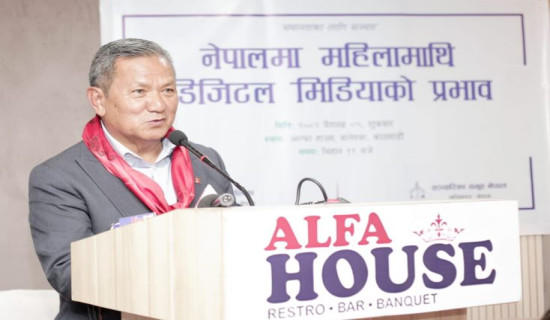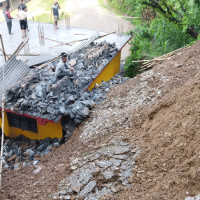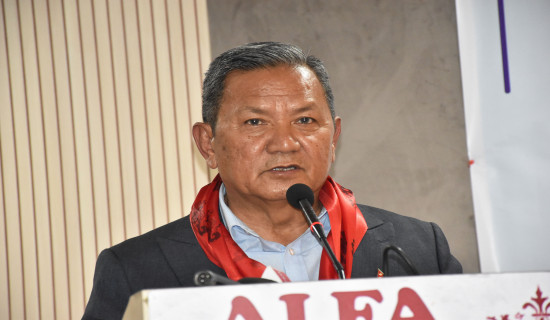- Saturday, 19 April 2025
The Year 2081 BS
Nepal Shows Resilience In Adversity
Nepal has witnessed notable social, political and economic events in the year 2081 B.S. (April 2024 - April 2025) that we are bidding adieu. The year was marked by both progress and adversity. The economic sector showed signs of recovery with strides in the hydropower sector. But natural calamities, including monsoon-induced floods and landslides, brought widespread destruction, while accidents – including deadly plane crashes and highway landslides – were devastating. Such a disaster not only highlighted a gap in infrastructure and disaster preparedness but also reflected Nepalis’ resilience despite piled-up frustrations that exploded in the streets. The anti-systemic agitations are a wake-up call for the parties that are seen unable to live up to the soaring public expectations.
The country experienced significant political developments, including leadership changes, policy shifts and public movements. On 14 July 2024, Prime Minister Pushpa Kamal Dahal Prachanda resigned after losing a vote of confidence in the House of Representatives. CPN-UML chair KP Sharma Oli was appointed as the new Prime Minister on 15 July, with the support of the Nepali Congress and other political parties. The formation of the NC-UML coalition government was a departure from the creation of previous governments. The two largest parties joined hands to ensure political stability, good governance and rapid economic growth.
NC-UML government
On April 10, Yam Lal Kandel of UML assumed the role of Chief Minister of Karnali Province with support from the CPN (Maoist Centre) and CPN (Unified Socialist). On 4 August, following a national-level alliance between the Nepali Congress and UML, Kandel reshuffled his cabinet, incorporating members from the Nepali Congress. On April 24, after an order from the Supreme Court, Nepal's National ID and Civil Registration Department directed local authorities to provisionally register same-sex marriage in a different ledger.
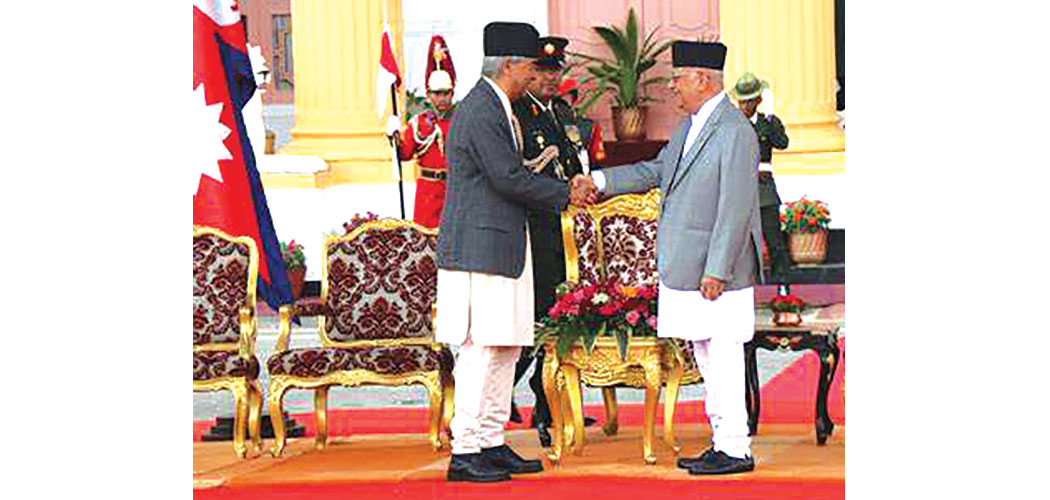
In early December, Prime Minister Oli visited China. Nepal and China signed a framework for Belt and Road Cooperation in Beijing on December 4, picking 10 projects to be executed under the Belt and Road Initiative (BRI). This visit was significant in further boosting Nepal-China relations and diversifying Nepal’s international trade and partnerships.
On March 28, pro-monarchy demonstrators converged in Kathmandu, calling for a return to the monarchy and Nepal's status as a Hindu nation. However, the protest turned violent, killing two people, including a journalist, and while numerous others sustained injuries in confrontations with police.
In October, Nepal, alongside Bhutan, sought Indian investment to accelerate hydropower development. The country plans to produce 28 GW of hydroelectric power within the next 10-12 years to export to India. Also in the same month, the World Bank forecasted a 5.1 per cent economic growth for Nepal in fiscal year 2025, fuelled by increased tourism, rising electricity generation and remittance inflows. However, economic challenges, including banking sector stress (non-performing loans) and a slow economic recovery post-pandemic, persisted.
Natural disaster
Nepal was almost brought to its knees when rain-induced floods and landslides hit the country in September. The country’s vulnerable geography could not withstand intense monsoon activity. Continued and heavy rainfall from June to September triggered widespread floods and landslides, mainly in the hilly and mountainous regions. Over 300 people lost their lives, with many injured and displaced.
Continuous rainfall between 26 and 28 September resulted in multiple incidents of flooding, inundation and landslides across the country. Kathmandu witnessed record rainfall, which was the highest ever rainfall in the valley’s recorded history, surpassing the previous record set in 2002. The government provided Rs. 200,000 to the families of those who died in the floods and landslides. The families of the missing persons were each also provided with the same compensation. The government provided free treatment for all the individuals injured in the disaster.
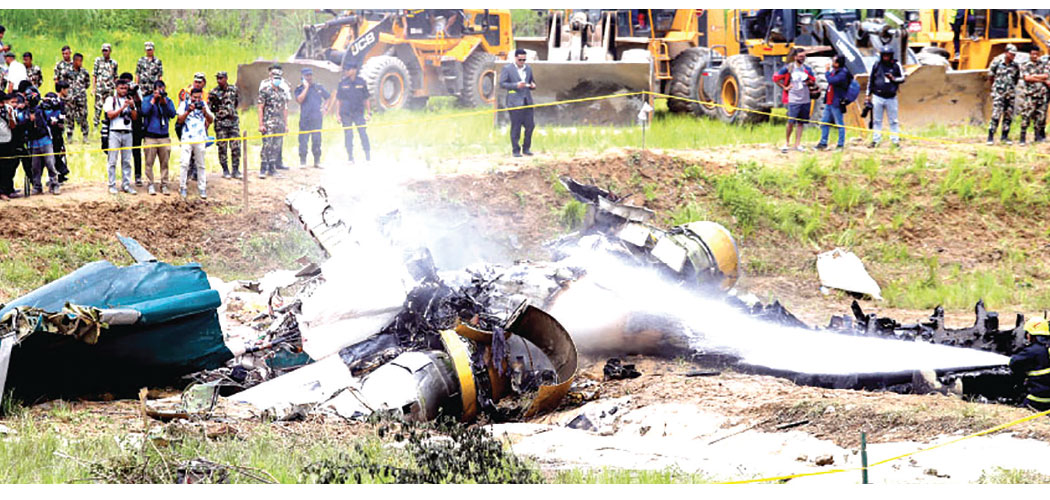
Many districts of Province 1, Bagmati, Gandaki and Lumbini were worst affected. Rescue operations were difficult as many bridges, roads and shelters were washed away. Kathmandu Valley also suffered widespread displacement and destruction. The National Disaster Risk Reduction Management Authority (NDRRMA) coordinated with the local governments for relief efforts. The government set up emergency shelters, and food and medical supplies were airlifted to remote areas. Despite efforts from the government, there were delays in response and infrastructure challenges that affected timely rescue and support.
Major accidents
On 12 July, a massive landslide struck the Madan Ashrit Highway in Chitwan, pushing two passenger buses into the Trishuli River. During such a disaster, at least 19 people died, and more than 40 went missing. Rescue efforts were affected by poor weather. The tragedy shows how vulnerable Nepal’s highways are during the monsoon season. On 24 July 2024, a Saurya Airlines flight crashed and caught fire while taking off from Tribhuvan International Airport, killing 18 people on board. Surprisingly, one survivor, the captain, escaped from the jaws of death. The plane carrying two crew members and 17 technicians was heading for regular maintenance at Pokhara airport. This accident highlights the negligence of the authorities on the poor air safety record.
In 2025, especially during February, March and April, forest fires spread in the mid-hills of Nepal, including Baglung, Ramechhap and Sindhupalchowk. Due to the dry conditions, these fires destroyed forests and biodiversity and posed health risks due to air pollution. Kathmandu Valley has been recorded as one of the most polluted cities in the world.
International events
Between April 2024 and April 2025, the world witnessed many important happenings in politics, international relations, and those related to environmental problems. On April 9, 2024, more than 100 people lost their lives as a ferry capsized and sank off Mozambique’s northern coast. The container that crashed had 130 passengers and was supposedly overloaded, and the ferry containers were unauthorised to transport passengers.
On April 10, 2024, the United Kingdom and Ukraine signed a framework agreement on cooperation on defence and arms production agreements. This partnership was to help improve Ukraine's domestic weapons industry, given the war was still ongoing. The G7 Foreign Ministers' Meeting from April 17 to 19 in Capri (Italy) focused on global issues when they met. Attention was placed on the Middle East and Ukraine issues, with parts of the meeting focused on peace efforts in Gaza.
India's general elections started on April 19, 2024, and lasted until June 1 and had elections that took place in 28 states and eight federal territories. Prime Minister Narendra Modi, 73, was reelected for a historic third consecutive term on his promise of employment generation, a better economy and citizenship laws. U.S. military actions in Yemen began on March 15, 2024. Therefore, the United States began air and naval strikes against Houthi targets in Yemen. This operation was aimed at halting Houthi attacks on commercial vessels in the Red Sea and Gulf of Aden.
The US presidential election was held on 5 November 2024. Former President Donald Trump was re-elected as the 47th President of the United States, defeating Vice President Kamala Harris. The Republican Party also regained control of the Senate and maintained its House majority. On April 2, 2025, President Donald Trump announced sweeping tariffs, including a 10 per cent baseline tariff on all imports.

In response, China imposed a 34 per cent tariff on all U.S. imports beginning on April 10 and restricted exports of important rare earth elements. France called for a strong but measured response from Europe to avoid further escalation. In June 2024, the EU had its five-yearly parliamentary elections in which right-wing parties saw rising support affecting the bloc's policies and coherence. In January 2025, the UK had a general election resulting in a change of government and a change in the UK's attitude towards the global politics of the day.
The International Summit on Energy Security was held in London on April 24-25. Called by the International Energy Agency (IEA) and hosted by the UK government to address the evolving nature of energy security challenges in correspondence to geopolitical realities and technological shifts. On February 12, 2025, US President Donald Trump and Russian President Vladimir Putin held a phone conversation marking the first direct exchange since the onset of the conflict in Ukraine. They agreed to initiate negotiations aimed at ending the conflict.
In April 2025, the largest protest against the second Trump administration saw over 1,000 "Hands Off" demonstrations across the US, focusing on issues like the firing of federal workers, government shutdowns, deportation, cuts to health programmes, and the rollback of protections for transgender people. Organised by over 150 groups, including civil rights organisations, labour unions, LGBTQ+ advocates, and veterans, the protests culminated in a sea of placards and banners on the National Mall in Washington, voicing anger at Trump and his billionaire ally, Elon Musk.
Severe weather events
On April 1, strong storms resulted in tornadoes in Turkey and Greece, causing significant damage. Fro m April 1 – 3, a major tornado outbreak affected the Southern and Midwestern regions, leading to casualties and property damage. These events reflect a dynamic marked by shifts in environmental challenges that have influenced the global landscape.
Globally in 2024, climate change contributed to an average of 41 additional days of dangerous heat. Such an increase exposed millions to higher health risks and intensified heatwaves, droughts, wildfires, storms and floods. In April 2024, heavy rains in East Africa led to floods that resulted in at least 518 deaths or disappearances, primarily in Kenya. Similarly, Pakistan experienced flash floods, landslides and lightning strikes in April 2024, causing 143 fatalities.
Between April 2024 and April 2025, California suffered from extreme wildfires that destroyed over one million acres, caused widespread destruction and led to significant loss of life and property.
Most of the fires were driven by arson, accidental ignitions, and natural causes such as lightning. The wildfires also impacted environmental and economic aspects. Such a disaster highlights the urgent need for improved wildfire prevention and response strategies.
(The author is a journalist at The Rising Nepal.)



